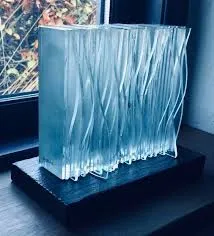Understanding Tinted Glass Types Enhancing Aesthetics and Functionality
In the world of architecture and interior design, tinted glass has gained significant popularity due to its aesthetic appeal and functional benefits. Tinted glass refers to glass that has been treated or coated to reduce the amount of visible light that can pass through, which not only enhances privacy but also improves energy efficiency. This article delves into the various types of tinted glass, their properties, and their applications, helping you make informed decisions for your projects.
Types of Tinted Glass
1. Heat-Absorbing Glass As the name suggests, heat-absorbing glass is designed to absorb solar heat rather than reflect it. This type of glass can help in reducing the energy consumption of buildings, as it minimizes reliance on air conditioning systems. Heat-absorbing glass usually has a grey or bronze tint, which can vary in intensity. It's an excellent choice for commercial buildings situated in sunny areas.
2. Reflective Glass Reflective glass features a coating that reflects sunlight, thereby reducing heat gain and glare inside buildings. This type of glass is particularly popular in high-rise office buildings and skyscrapers. The reflective coating can be applied in various colors, such as blue, green, or silver, allowing architects to achieve the desired aesthetic while increasing energy efficiency.
3. Tinted Laminated Glass This variant combines tinted glass with a layer of polyvinyl butyral (PVB) or ethylene-vinyl acetate (EVA), enhancing its durability and safety. Tinted laminated glass not only reduces glare and heat but also provides protection against UV rays. It's commonly used in residential windows, skylights, and shower doors, where safety and aesthetics are equally important.
4. Colored Glass Unlike conventional tinted glass, colored glass is infused with ceramic pigments during the manufacturing process, resulting in vibrant hues that do not fade. Available in a wide range of colors, this type of glass is often used in artistic applications, such as stained glass windows or decorative partitions. Though primarily decorative, colored glass can also offer some level of light filtration and UV protection.
tinted glass types
5. Ceramic Frit Glass This is a specialized type of tinted glass where a ceramic paint is applied and then baked into the glass surface. The result is a durable and resistant finish that can be produced in various colors and patterns. Ceramic frit glass is commonly used in facades and can dramatically impact a building's aesthetics while enhancing its thermal performance.
Benefits of Tinted Glass
The advantages of using tinted glass in construction are manifold. Firstly, it significantly reduces the glare caused by the sun, providing a more comfortable environment for occupants. Secondly, tinted glass can effectively block harmful UV rays, which are known to cause skin damage and fade furniture and fabrics.
Additionally, tinted glass plays a crucial role in energy conservation. By minimizing solar heat gain, it can lead to lower energy bills, making it an eco-friendly choice for many buildings. Many options are also available to fit specific performance requirements, such as acoustic insulation and safety ratings, catering to various project needs.
Applications of Tinted Glass
The application of tinted glass spans residential, commercial, and industrial sectors. In residential buildings, homeowners frequently choose tinted windows for increased privacy and comfort. Commercial buildings, particularly those with large glass facades, use reflective and heat-absorbing glass to enhance energy efficiency and reduce glare for employees. In manufacturing, tinted glass can be utilized in safety and security applications, given its additional strength depending on the type chosen.
In conclusion, tinted glass is more than just a design choice; it is a functional element that can enhance energy efficiency, provide comfort, and improve aesthetics. Understanding the various types of tinted glass and their applications allows builders, architects, and homeowners to make informed decisions that align with their project goals. Whether you prioritize energy efficiency, privacy, or sheer beauty, tinted glass offers a solution tailored to meet those needs.
 Afrikaans
Afrikaans  Albanian
Albanian  Amharic
Amharic  Arabic
Arabic  Armenian
Armenian  Azerbaijani
Azerbaijani  Basque
Basque  Belarusian
Belarusian  Bengali
Bengali  Bosnian
Bosnian  Bulgarian
Bulgarian  Catalan
Catalan  Cebuano
Cebuano  Corsican
Corsican  Croatian
Croatian  Czech
Czech  Danish
Danish  Dutch
Dutch  English
English  Esperanto
Esperanto  Estonian
Estonian  Finnish
Finnish  French
French  Frisian
Frisian  Galician
Galician  Georgian
Georgian  German
German  Greek
Greek  Gujarati
Gujarati  Haitian Creole
Haitian Creole  hausa
hausa  hawaiian
hawaiian  Hebrew
Hebrew  Hindi
Hindi  Miao
Miao  Hungarian
Hungarian  Icelandic
Icelandic  igbo
igbo  Indonesian
Indonesian  irish
irish  Italian
Italian  Japanese
Japanese  Javanese
Javanese  Kannada
Kannada  kazakh
kazakh  Khmer
Khmer  Rwandese
Rwandese  Korean
Korean  Kurdish
Kurdish  Kyrgyz
Kyrgyz  Lao
Lao  Latin
Latin  Latvian
Latvian  Lithuanian
Lithuanian  Luxembourgish
Luxembourgish  Macedonian
Macedonian  Malgashi
Malgashi  Malay
Malay  Malayalam
Malayalam  Maltese
Maltese  Maori
Maori  Marathi
Marathi  Mongolian
Mongolian  Myanmar
Myanmar  Nepali
Nepali  Norwegian
Norwegian  Norwegian
Norwegian  Occitan
Occitan  Pashto
Pashto  Persian
Persian  Polish
Polish  Portuguese
Portuguese  Punjabi
Punjabi  Romanian
Romanian  Russian
Russian  Samoan
Samoan  Scottish Gaelic
Scottish Gaelic  Serbian
Serbian  Sesotho
Sesotho  Shona
Shona  Sindhi
Sindhi  Sinhala
Sinhala  Slovak
Slovak  Slovenian
Slovenian  Somali
Somali  Spanish
Spanish  Sundanese
Sundanese  Swahili
Swahili  Swedish
Swedish  Tagalog
Tagalog  Tajik
Tajik  Tamil
Tamil  Tatar
Tatar  Telugu
Telugu  Thai
Thai  Turkish
Turkish  Turkmen
Turkmen  Ukrainian
Ukrainian  Urdu
Urdu  Uighur
Uighur  Uzbek
Uzbek  Vietnamese
Vietnamese  Welsh
Welsh  Bantu
Bantu  Yiddish
Yiddish  Yoruba
Yoruba  Zulu
Zulu 

